Tourists/Terrorists – Useful Ambiguities in a Search for Models
Phil Smith
University of Plymouth
[1] A discussion about models of 'ideal', resistant, small group organisation is generally pre-empted by an argument about intentions. What is the group for?
[2] The principle seems obvious – there must be an 'end' of some kind that drives and determines the means, however that relation works itself out.
[3] Yet, so often, the histories of group organisation, whether philanthropic, political or recreational, are of empirical specificities turning out to be far more rich and potent than mere means; that it is in their details that the larger structures of what they become first emerge: the Provisional IRA become custodians of a peace agreement, the crusading Knights Hospitaller of St John metamorphose into first-aiders at sports events.
[4] This potential for convenient, utilitarian tactics to turn suddenly (and often stay turned) towards a qualitatively new strategic end is sometimes spotted early on and snuffed out. In the 1920s a rag-tag, barely coherent orrery of proletarian UK-based Marxist philosophers, already beginning to establish their own eccentric, vernacular tradition, was halted by their recruitment to the Communist Party of Great Britain. In the Second World War, the first manifestation of a UK 'Home Guard' (an official civilian defence force raised to fight Nazi invasion), was dismantled; initially trained by Spanish anarchist miners, refugees from Franco, it was developing an insurgent, revolutionary structure among its base of early members.
[5] So, rather than establish an 'end', and then seek a model for the group structure most likely to achieve it, I propose to present here the details of various existing and historic small group practices with resistant, covert or disruptive qualities, flagging up different fragments, slivers, signatures, eccentricities and tics, with the intention of whirling these around the meandering practice of the International Lettriste/situationist dérive (or drift), or at least around an 'ideal' version of the practices of contemporary dériviste groups, some modelled precisely and others imprecisely on the dérive. (My account of some of these is here.)
[6] The context for this speculative modelling is an ongoing series of experiments with various forms of exploratory and 'disrupted' walking: these began with drifts, but have moved on to subversions of the guided tour, the making and placing of détourned signage, collective pilgrimages interweaving multiple-practices and improvisations and the distributions of guides, handbooks, maps and toolkits as provocations for others to make their own resistant walking.
[7] While I have attempted elsewhere - online and in Mythogeography (2010, Axminster, UK: Triarchy Press) – to document these experiments and those conducted by others and to tentatively build a critical scaffold around them, it is the historical dérive that remains the dominant example of the 'ideal' collective walk (despite other models from urban exploration, deep mapping, live art and pedestrian activism). By attaching a plethora of variegated practices and other models of small group intervention to this 'ideal' I hope, here, to shift the dérive a little from the centre of the orrery of these multiplicitous practices; to set in motion other bodies of attraction.
[8] Given the benefit to these small group practices of the deferral of ends – including the deferral of even discussing ends for as long as possible - a key dynamic of such 'drifting groups without destinations' can be understood through a creative system identified (in stark corporeal terms well suited to an immersed walking group) by the artist Matthew Barney. In this system 'Situation' (no relation) is the raw energy and drive of undirected intentionality, 'Condition' is the direction and digestion of this energy, and 'Production' is its oral/anal expression in the form of excretions of art, political actions, etc. Barney's creative method is to disrupt this sequence, deferring 'Production' again and again and repeatedly folding 'Condition' back into 'Situation', whirling the latter's energy again and again in a violent short circuiting through the funnel of 'Condition' until the organic structure of the process cannot sustain itself as its accelerates, at which
[9] Similarly, a drifting group (with neither end nor destination) bounces back and forth between different theoretical positions in the course of a single drift – between (a more or less understood) Debord, Bachelard and Baudrillard, for example – drawing, opportunistically, from different theories as they are required; contesting the dominance of visuality one moment, drawing pseudo-evolutionary allusions or tracing a string of voids the next. Ideally (because, for the sake of this argument, they are an 'ideal'), such a group would extend their versatile inconsistency until it becomes an unsustainable contradiction; when unexpected, unplannable, inconvenient praxes are hurled off.
[10] What Barney's model seeks to do is pre-empt reproduction, to disrupt the tendency of 'creative' or disruptive action to follow a course of least resistance to a product, to find its way too quickly, efficiently and conveniently to an outcome (when production takes on the quality of an organism's excretion).
[11] Among drifting groups certain productive scenarios recur, such as the play of childhood, attraction to ruins and the morbid, the seeking out of the 'hidden', the identification of occulted and occult iconographies or ironical and accidental signage, and trespass. While these may constitute the parts of a resistant walk, because they are familiar products of many drifts they can also pre-empt its destinationless engagement by a premature gratification (a powerful tool of the Spectacle) through the manifestation of what might already have been expected (or at least predicted). The result can be an immersion in a milieu (occult, anecdotal, historiographical); momentum is lost and a subtle bounding of space is imposed or adopted.
[12] However, by deferring the gratification (for example, by disrupting an action to maintain it in simultaneous development with others) territorialisation can be suspended to allow more and more layering of activities, one upon another: play upon vandalism upon mapping upon sculpting trash upon booby-trapping upon poetry upon dance... until the group itself cannot cope with the multiplicity of its own processes and, in that crisis, can retreat to a milieu or crash on to something or somewhere that is unexpected, unplanned and (this is the key political and reproducible aspect) uncontainable.
[13] This is not unlike the strategy of communes that is proposed by The Invisible Committee as a part of social insurrection:
it's not about possessing territory. Rather it's a matter of increasing the density of the communes, of circulation, and of solidarities to the point that the territory becomes unreadable, opaque to all authority... Every practice brings a territory into existence – a dealing territory, or a hunting territory; a territory of child's play, of lovers... or flaneurs. The rule is simple: the more territories there are superimposed on a given zone, the more circulation there is between them, the harder it will be for power to get a handle on them... (The Invisible Committee, 2009:108)
and the greater the likelihood that outcomes are unplannable and uncontainable, not only for those who seek to control them, but (more importantly for a situationist politics) for those who seek to create them, for, according to a situationist critique of the Spectacle, it is by such creators (who are the subjects of this essay, and I include my own culpability) that some of the most effective policing of geographical power is carried out.
[14] A charged drift, capable of resisting the rush to produce and folding back its own energies upon itself, may serve as a disruption of everyday life, but it is not a substitute or replacement for it; the disruptiveness of the drifting group is neither the portal to a lifestyle choice, nor a day pass to a new milieu. While it may disrupt the quotidian, it, in turn, needs to be disrupted by an episodic return to it. (I will argue in the conclusion to this paper that, due to the spectacularisation of everyday life, the charged 'drift' can best re-enter the everyday through intense, but banal spaces such as those of tourism.)
[15] Attentive readers will have noticed that I have already done some violence to the concept and history of the dérive. The situationists did have a purpose (and in that sense a destination) for their drifts; they were opportunities for the collection of psychogeographical data for use (less than well defined) in the construction of exemplary situations (limited actions prefiguring transformed social relations). While the dérive remains the polar influence for exploratory walking, I have detached it from its task (as have so many other 'psychogeographers', though for other reasons, predominantly literary and occult) in order to render its dominant influence over my own purpose relative rather than absolute.
[16] This ambiguity around the tactics of psychogeography is not the weakness it is generally cracked up to be. Certainly, the failure of the situationists to explain situations in a way that links such praxis to the gathering of psychogeographic data, and the plundering of the situationists' lexicon by occultists, tourism consultants, authors, film-makers and literary critics has led to a disconnection of psychogeographical tactics from strategies. However, in the context of an actual drift that distinction, and the dynamic of 'what is serving what', is revealed as a symptom of terrain rather than political programme. The ambiguity of psychogeographical politics, while compromising the individual dériviste, delivers in that very abjectness a return to site specificity as the 'grounds' of the ambiguous group traversing its sites; these 'grounds' then are 'particularity of terrain' (rather than theory) and 'flexibility of tactics'.
[17] The internal relations of the ideal drifting group are equally ambiguous; toying with their own dissolution. Its fictional model comes from G. K. Chesterton's novel The Man Who Was Thursday, in which an atheistic, anarchist group turns out to have consisted (almost) entirely of infiltrators from a variety of secret services. In non-fictional (but queasy) reality, the Bolsheviks discovered a similar situation among their Duma representatives; the October revolution in 1917 exposed their most conscientious and effective representatives as Tsarist agents.
[18] Such negation and 'disguise' can be turned inside out and adopted explicitly. The Clandestine Insurgent Rebel Clown Army, a UK-based coalition of left-leaning and anarchist clowns, reverses the model of infiltration. Openly 'in disguise' (in clown costume), they 'infiltrate' reactionary groups (police managing demonstrations, army recruitment centres) and offer their services. Not only does their clownish incompetence impede the authorities, but by taking these authorities 'at their word' and applying that 'word' literally and 'ad absurdam' (as with the immersion of the drift, taking affordances as offers) they expose contradictions implicit in the 'democratic' remits of these arms of the state.
[19] Then there are the walking memes, like The Charlie Circle in Adipur, a devotional group who venerate the art of Charlie Chaplin through imitation, procession and monument.
[20] Like amateur actors, the members of such 'ideal' groups of clowns and walking icons are uncomfortable in their roles. Superficial in their disguise, equivocal about psychological objectives and super-objectives (switching back and forth between different ends), they are characterless (in that they have no sub-text). Their masks do not disappear (as they do in psychological acting) but fall from them. They are clumsy in their use of 'props' and instruments. They are not traceless like 'special forces', but are like spear-carriers who upstage the instruments of scripting, incapable of blending into crowd scenes, they generate awkward pauses and put a spotlight on unsuspected voids.
[21] Such ideal drifting groups, despite their eccentricities, are often (and best) led by their peripheries, by the fraying of their purpose when thrown up against the everyday, by edges that catch upon the textures of the places passed through creating a generalised 'torque' that becomes the 'gestus' or 'idea' of the walk. While the group may play with disguise, even hiding in plain sight, it is engaged and sympathetic (at moments, even bound) to its sites. It is not traceless.
[22] The variability of the levels of seriousness, activity, violence and organisation among these 'ideal' groups is entirely down to their accidental and particular circumstances; the levels bear no relation to strategy, ethics, principle, or even to a task (when there is one). Take, for example, The 43 Group: it was made up mostly of Jewish ex-servicemen who had served in the British Armed Forces (43 at their founding meeting in 1945, rising to over 300 over the next five years). They organised themselves after the end of hostilities in Europe to oppose a nascent far-right movement in parts of London that included Oswald Mosley's British Union of Fascists and the British League of Ex-Servicemen. The 43 Group broke up fascist meetings, violently confronted fascist newspaper sellers (sometimes forcing the sellers to eat their own newspapers), they infiltrated their members into these organisations to gather intelligence, and they went as far as using injected drugs to disable sentries and burgle fascist headquarters. Through all this they succeeded in retaining discipline among their members, operating beneath the legal radar without falling into criminality; they tapped the resources of sympathetic benefactors and deployed a violence limited within strict (if sometimes extreme) parameters. Without the shared and circumstantial organisational experience drawn from their military service, it is unlikely that such 'extreme' actions would either have been adopted (other Jewish organisations preferred to lobby the authorities) or have been containable and directable. Their tactics were not determined by a theoretical or strategic analysis of their enemy nor by a clear understanding of their own 'aims', but by what was 'to hand', by their circumstantial, tactical possessions, by their familiarity with military operations with limited and specific objectives. Given this inherited discipline, the group (its job done) was able to voluntarily disband in 1950 without generating splinter groups (unlike, say, the so-called "dissident republicans" operating presently in the North of Ireland) and then effectively 'disappear' (until their story was published by one of their leading former members in the1990s).
[23] It is the principle of 'to hand' and the raising of contingency to a principle (through immediate judgements about which tactics to apply to what affordances) that can be drawn from these group narratives (even of those as end-oriented as The 43 Group). But there is nothing to be drawn and reapplied from the narratives themselves. The 'ideal' dériviste group does not imitate any other group, but has a memory-map of the circumstances-tactics-strategy relations of a range of groups, drawing on those relations (but not on their constituent parts, for which each new group must find or learn their own).
[24] The history of considered self-abolition, common among resistant groups, and companion to their capacity for abrupt change, is a useful one when balanced against a tendency to become ends in themselves. At a micro-level, specific drifts are often characterised by a re-negotiation of connections, an abandonment of loyalty, for the limited period of the drift, to anything other than the group and the landscape it passes through. Often without maps, and on unfamiliar ground, without any destination, the group develops a mutual reliance appropriate to more extreme circumstances. To know what resources can be drawn up, openness is necessary. For the past ten years I have fielded the responses of participants after their first drifts; those (a small minority) who found the experience uncomfortable often had a commitment to walking alone or to the reverie of flânerie and baulked at the drift's requirement for utilitarian self-revelation.
[25] While this openness and assemblage of variable skills, predilections and preoccupations tend towards an inter-weaving of the group, this does not necessitate boundedness. Dependent on the tightness or looseness of the 'meshing' of the space, the group can make ground by splitting up into groupuscules, sometimes even proceeding as individuals and then reforming further on down the track. This process, almost a pulse of diffusion and concentration, happens all the time within a drifting group, but it can also be consciously deployed by the group as a whole when circumstances afford or require.
[26] There are guerrilla groups, some very different from those serious, task-oriented organisations like The 43 Group, which, although set up under the guise of self-indulgence, have operated politically, financially and benevolently; moving 'beneath the radar' by virtue of their apparent lack of seriousness: The Society of Dilettanti, for example. Established in 1732 as a male-only London dining club (in 1734 one of their dinners ended in street fires, fights and the arrival of guards from St James' Palace) the members of the Society attempted to recreate the license to outrage that they had enjoyed on the 'Grand Tour' while seeking to diffuse 'good taste' among the general public. Society members channelled large sums of money into the development of opera in Britain and into numerous archaeological projects (without ever getting their hands dirty), concluding their activities in 1786 with the publication of Richard Payne Knight's A Disquisition on the Worship of Priapus. The Dilettanti pre-empted the situationists by describing their activities as "seria ludo" (serious play).
[27] The activities of an equally well-heeled (but this time all female) group formed in 1930 also match the description of "seria ludo": Ferguson's Gang. Individual members adopted semi-mythic pseudonyms that included "The Bloody Bishop", "Bill Stickers", "Red Biddy" (named for her leftist sympathies), "Erb the Smasher", "Silent O'Moyle", "Black Maria", "the Lord Beershop of the Gladstone Islands & Mercator's Projection" (a former student of the Slade) and "The Nark". Their aims were culturally conservative: to 'preserve' the English countryside (mainly by supporting the work of the National Trust), a contradictory and self-negating task. And yet, perhaps to compensate, they adopted a radical behaviour; communicating their aims and recording the minutes of their meetings (in their 'Minute Boo') in mock-cockney dialect, delivering donations in the cadaver of a goose, trespassing on derelict properties where they would hold secret meetings before endowing large sums for their renovation, and turning up for interview at the BBC in full face mask. They maintained a discipline of anonymity similar to The 43 Group's; only one of the Gang has ever been identified by
[28] While the specific tactics of these different groups will remain mostly untransferable to other circumstances, there are specific dynamics that are retrievable from their histories: distraction, hiding in plain sight, the use of whatever the circumstances of the group and its terrain provide, internal openness, asymmetrical engagement with institutions, serious play, the exaggerated use of spectacular icons, self-narration and the group's control of its own historiography (or anonymity) and ontology. The latter quality in particular presents a challenge to communications between these groups, let alone co-ordinated or collectively provoked activities; but this 'problem' is part of a temptation to assume that, after assembling such a chaotic tool kit of uneven practices, that the next challenge for the drifting group would be one of coordination and action (how to increase their influence), that over those who have the temerity to 'do' – to rearrange, to deterritorialise, to push through and re-assemble – hangs an obligation to site these actions on an ever grander scale.
[29] Where "doing" accrues an obligation to define principles and to explain oneself in terms of wider ambitions, greater changes, broader programmes and more complex arguments, the problem lies not with the trajectory, but its pre-emptive velocity. For at this point, the least useful thing to do is to begin a discussion of ends and means; for this is the moment when a deferral of these questions is possible and consequential, allowing the groups to understand themselves in their own terms (rather than comparing themselves to previous or exterior models), and to generate and accumulate actions and experiences and 'Condition' (by repeated deferral of the question of strategy), plugging these back into the group's initial 'Situation' (its impulse to drift), and creating the virtuous cycle that can hurl out unplanned-for and unplannable strategic possibilities for drifting in general.
[30] This is the key moment for the small group. When, in order to resist the tendency to reproduction, it must repeat itself and find the courage to accept criticisms of unoriginality, derivativeness, lack of imagination and conservatism in order to delay innovation until it becomes not a possibility, but impossible to avoid. One example of such a moment when by conservatism, and through repetition, the centre of a group's activity was destabilised was the transition between the publications An Exeter Mis-Guide and A Mis-Guide To Anywhere by the Exeter drifters Wrights & Sites. The warm reception of A Mis-Guide To Anywhere led the group to first explore and then recoil from the idea of producing Mis-Guides for other cities, uneasy about just how site-specific they could be to cities they did not know intimately. And yet the return to specificity on the familiar terrain of their own city precipitated the group's leap from the specific to the generic (of an only partly ironical Anywhere). The move to generalise on a terrain of connectedness and generic provocation came initially from a retreat from just such an aspiration to spread their practice; it was only when their repetition of specificities refused to remain within their own terrain that the group were robbed of their 'centre' (site-specificity) and spiralled outwards towards an unexpectedly wide elsewhere.
Personae
[31] At the end of David Mamet's movie 'The Spanish Prisoner' (1997), the key narrative agents are revealed as a group of camera-toting Japanese tourists (in fact Japanese-American FBI agents working undercover) who, despite repeated appearances in the movie, have been ignored by both the characters and the audience. In 2007 the organiser of a series of training camps for potential suicide bombers in the UK was apprehended by the authorities and jailed. The training he had arranged was conducted under the guise of walking holidays, hiking expeditions and paintballing sessions in popular UK beauty-spots. No one who saw his groups could distinguish them from adventure tourists.
[32] What is proposed here is that these are examples of something more than instrumental disguise. Rather, that there is a flexibility here that a dérive-oriented (but increasingly de-centred) orrery of groups can take advantage of; that there is in the ambiguous terrain between tourism and covert operations (whether terroristic or counter-terroristic) a model for the deferral of a move from experimental tactics to the adoption of strategy, leaving the way open for less predictable and more emergent dispersals and deterritorialisations.
[33] Like a covert group, an 'ideal' drifting group moves in holey-space; sometimes 'burrowing' into the hidden, subterranean corridors of a location (seeking out the reserve collections, the space beneath the stage where the bust of a fallen dictator is stored 'just in case', the places of maintenance and offices of surveillance and coordination), but also moving through crowds as if through corridors. A drifting group can become so disconnected from spectacular relations of consumption that it is almost invisible to consumers and is irrelevant to (and ignored by) retailers. (The anti-functionality of a drift means that dérivistes usually avoid retail relationships, except when they are taking an establishment 'at its word' and enacting levels of generosity, concern or hospitality through helpfulness, conviviality and conversation that are implicit, but too rarely explicit; for example in café or restaurants.) Such a group may adapt quantum-tunnelling or mole-like behaviours; in the first case borrowing information from the landscape to make connections (apparently spooky "actions at a distance") to commercial and information trajectories, or, in the latter case, burrowing through space in a way comparable with attack-helicopters engaging fixed-wing aircraft, seeking to make advantageous, asymmetrical connections with a more powerful enemy.
[34] Because the drifting group differs from the covert group by its deferral of narrative denouement or violent outrage (or a violent arrest of it), it can be open and straightforward about its operations, just as tourists (as understood by contemporary Tourism Studies) might be about their tourism: they are here to re-make the meaning of a place by their participation in, use of and journey through it. Even at its most extreme and performative (something like the invasions of the Clandestine Insurgent Rebel Clown Army or the actions of the live artist The Vacuum Cleaner whose prayers of thanksgiving for consumer items are recited in chain stores) the drifting group's actions seek to subvert a space by over-obeying its rules; by détournement on a social scale. The drifting group defers the violence of its resistance (and the articulation of its strategic opposition) to
[35] In some contexts, however, even relatively dampened behaviour can bring drifting groups to the attention of security professionals, drawn perhaps by a group's lack of retail involvement or the intensity of a group's observation of the non-signalled parts of a site. The drifting group is not a truly covert group; in the context of Western bourgeois democracies it has no need to be. Its activities may appear to state and private security operatives as unconventional, irrational or eccentric, but hard to identify as criminal. But what the drifting group does share with terrorism (in its individualist, nationalist and particularly its state versions) is an attempt to create (for very different purposes) a 'state of anxiety and tension', a dread or hyper-sensitivity like a low-level paranoia in which the default state of public life shifts from a base assumption that what we see and experience is mostly accidental, meaningless, providential and innocent to one that what we see is mostly organised, meaningful, exploitative and dangerous. What the security operative responds to when she or he interrupts a static drift in the shopping mall or an obsessive group investigating iconography in a 'sensitive' national heritage site is a prefiguring of a paranoid public:
Freeman & Freeman have described a "sliding scale" of paranoia, a key indicator of which is "how much the thoughts interfere with everyday life". But what if that interference could be mapped and controlled, as a chosen means to "interfere with everyday life"? Freeman & Freeman concede that paranoia can be chosen by society (they explain how the objects of paranoid fears in Vienna are very different from those in Tokyo) and yet they do not allow it to be 'chosen' by an individual. But what if we can? Then we have a tool. (Smith, 2010: 165, citing Freeman & Freeman, 2008.)
It is no accident (to fold the low level paranoia of this essay back upon itself) that the ambiguous figure of the tourist has been gently emerging as a shadow model here. Given the accelerating transfer of many qualities of the tourist site to the urban everyday - "almost everywhere has become a centre of 'spectacle and display'... resorts now have relatively little to distinguish themselves from elsewhere" (Urry, 1990: 93) - and the tourist's agentive role emerging from the Tourism Studies of the last two decades, 'the tourist' will increasingly serve as a useful persona for dérivistes able to sustain the ambiguity of the "golden horde" and the reflexive "post-tourist".
[36] Given the provisional starting point of this argument in the practice of a passage through space with hyper-attentiveness to texture and detail, certain possibilities in the practice of the "post-tourist" (for example, their enjoyment, self-consciously, of the artificiality and ironical 'mis-speakings' of the leisure space) and the "anti-tourist" (who resists the consumption of the space's ideological productions) begin to look like 'ideal' personae for the members of an 'ideal' group. This, and the mistaking of terrorists for tourists (a symptom of the break up of mass tourism and the decline of the passive consumer), signals a space within the tourism, leisure and heritage industries and their sites in which to develop dérive-centred, 'ideal', resistant groups operating as 'industrial' dis-organisers and re-routers, bridging these intense sites back to a lived critique of everyday life.
Gallery
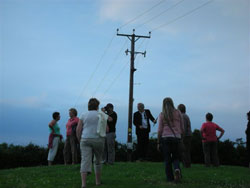
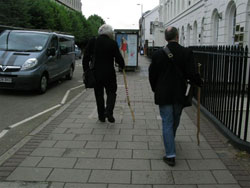
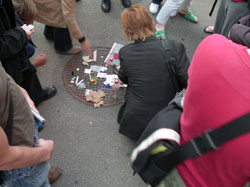

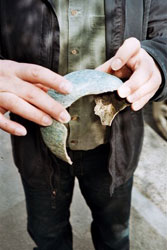
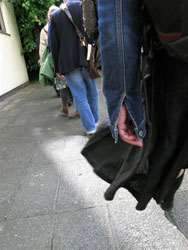
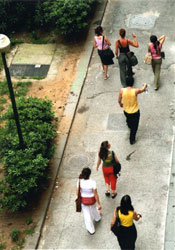
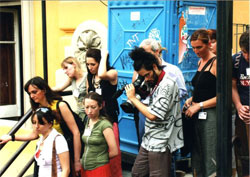
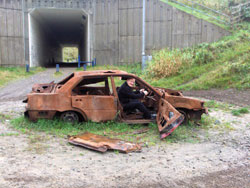
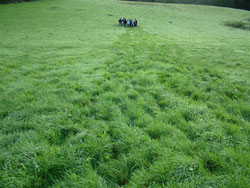
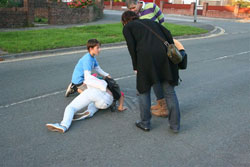
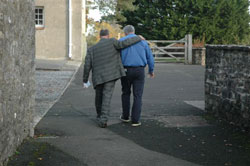

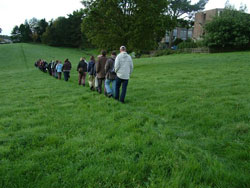
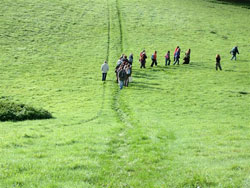
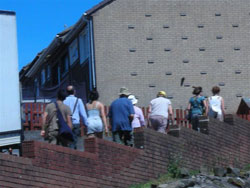
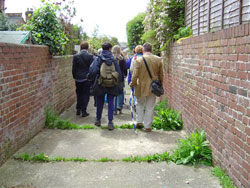
References
Freeman, D. & Freeman, J. (2008) Paranoia: the 21st-century fear, Oxford: OUP.
Smith, P. (2010) Mythogeography, Axminster (UK): Triarchy Press.
The Invisible Committee. (2009) The Coming Insurrection, Los Angeles: Semiotext(e).
Urry, J. (1990) The Tourist Gaze: Leisure and Travel in Contemporary Societies, London, Thousand Oaks, New Delhi: Sage.
Links
"Knights Hospitaller of St John". middleages.org UK. Website.
«http://www.middle-ages.org.uk/knights-hospitaller.htm»
St. John Ambulance UK. Website. «http://www.sja.org.uk/sja/default.aspx»
Mackenzie, S.P. (1991) "Citizens in arms: The home guard and the internal security of the United Kingdom, 1940-4"1. Intelligence and National Security, Vol. 6:3. 548-572. «http://www.informaworld.com/smpp/content~db=all~content=a789093337»
"Everything you need to build a town is here". Wonders of Weston. Website. «http://www.wondersofweston.org/artworks/everything-you-need-build-town-here»
"Gallery". English Riviera Global Geopark. Website. «http://www.englishrivierageopark.org.uk/gallery.cfm?gid=541»
"About Mis-Guides". Mis-Guide. Website. «http://www.mis-guide.com/mg.html»
Smith, P. (2010) "Mythoarchive". Mythogeography. Website.
«http://www.mythogeography.com/2009/11/a1.html»
Tomlinson, Ben. (2007) "Matthew Barney: Drawing Restraint". Review. Artvehicle 25. Website. «http://www.artvehicle.com/events/75»
Chesterton, G.K. (1908) The Man Who
Was Thursday. Project Gutenberg.
«http://www.gutenberg.org/etext/1695»
"Rebel Clowning: What Is It?" The Clandestine Insurgent Rebel Clown Army. Website. «http://www.clownarmy.org/rebelclowning/rebel.html»
The Charlie Circle. Website. «http://charliecircle.wordpress.com/»
Gould, Mark. (2009) "They stood up to hatred". The Guardian. «http://www.guardian.co.uk/society/2009/jan/27/holocaust-memorial-day-43-group-public-event»
The National Trust. "Archive photograph of three members of the Ferguson Gang enjoying a picnic in 1935". National Trust Prints.
«http://www.ntprints.com/image.php?id=358311&idx=10&fromsearch=true»
